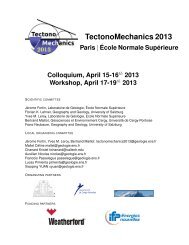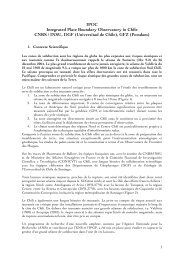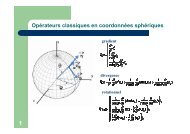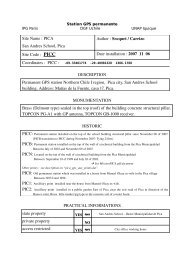PDF file - Laboratoire de Géologie de l'Ecole normale supérieure - Ens
PDF file - Laboratoire de Géologie de l'Ecole normale supérieure - Ens
PDF file - Laboratoire de Géologie de l'Ecole normale supérieure - Ens
You also want an ePaper? Increase the reach of your titles
YUMPU automatically turns print PDFs into web optimized ePapers that Google loves.
MICROBLOCK ROTATIONS IN SULAWESI, INDONESIA<br />
velocity estimates with an uncertainty (1-σ) ranging from<br />
0.3 to 1.5 mm/yr for the sites that were measured at least<br />
3 times.<br />
Obtaining a consistent velocity field<br />
The Palu transect velocities are processed relative to<br />
the westernmost station of the transect, WATA. In or<strong>de</strong>r<br />
to get the velocities of the transect in a global reference<br />
frame, we simply add the velocity of WATA in ITRF-<br />
2000 to all the points of the transect. In doing this we<br />
assume that the transect is affected only by translation at<br />
such a small scale (60 km at most). In<strong>de</strong>ed, the two<br />
in<strong>de</strong>pen<strong>de</strong>nt <strong>de</strong>terminations (relative and regional) of the<br />
velocity of the transect’s easternmost site (TOBO, also<br />
continuously measured) with respect to that of WATA<br />
agree within 0.6 mm/yr. The velocities (in the ITRF2000)<br />
of this combined solution (regional + relative) are listed<br />
in the electronic supplement.<br />
Mo<strong>de</strong>lling the velocity field<br />
Description of the velocities in Sulawesi area<br />
We specify several tectonic blocks in the Sulawesi<br />
region based on the GPS velocities and the geological<br />
and seismological evi<strong>de</strong>nce for active faulting. Figure 2<br />
displays the velocities relative to the Sunda plate<br />
reference frame [Simons et al., subm.; Socquet et al,<br />
2006] and figure 3 shows the focal mechanisms in the<br />
same region. The first obvious pattern from the GPS<br />
velocities is the division of the island into two<br />
in<strong>de</strong>pen<strong>de</strong>nt domains. In the south, the Makassar Block<br />
(grey arrows) displays a small but significant motion<br />
relative to Sunda appearing to rotate anticlockwise<br />
around a pole located near its south-western tip. The<br />
Makassar Trench (figure 4) bounds this block to the west<br />
and accommodates at least part of the Sunda / Makassar<br />
convergence. The East Sulawesi Trench constitutes the<br />
boundary of the Makassar and East Sula blocks with the<br />
Banda Sea. The northern half of Sulawesi (black arrows)<br />
moves toward the NNW and rotates clockwise around a<br />
pole located near its north-eastern tip. The northern half<br />
of Sulawesi is divi<strong>de</strong>d into 3 smaller blocks. The eastern<br />
part of the northern arm of Sulawesi, here named the<br />
Manado Block, has an in<strong>de</strong>pen<strong>de</strong>nt motion from the<br />
North-Sula Block. These two entities are separated by the<br />
Gorontalo Fault, evi<strong>de</strong>nt in geology. The boundary<br />
between the Makassar and North Sula blocks is the Palu-<br />
Koro fault. Lastly, the eastern arm of Sulawesi also<br />
shows in<strong>de</strong>pen<strong>de</strong>nt motion from North-Sula, indicated by<br />
west trending GPS vectors at sites LUWU, AMPA and<br />
KAMB. Due to the sparseness of our network in this<br />
area, more exact boundaries of this block (here named<br />
East Sulawesi) are difficult to draw. East of Sulawesi, we<br />
<strong>de</strong>fine the Banda Sea as a rigid block on which we have<br />
only 2 GPS velocities: at SANA and AMBO.<br />
5<br />
Figure 3: Post-1976 instrumental CMT focal mechanisms<br />
from Harvard catalogue in the Sulawesi area. The size of<br />
the symbol is proportional to the earthquake magnitu<strong>de</strong>.<br />
Focal mechanisms in grey, labelled by date<br />
(YYYYMMDD) and magnitu<strong>de</strong>, correspond to the<br />
earthquakes cited in the text.<br />
Data mo<strong>de</strong>lling approach<br />
The relatively small, rotating blocks are surroun<strong>de</strong>d by<br />
active faults where interseismic coupling produces elastic<br />
<strong>de</strong>formation within the blocks. In many instances, a<br />
substantial amount of the block’s surface is below sealevel<br />
and inaccessible to standard GPS measurements so<br />
only a part of the block has constraints. For example, in<br />
the northern half of Sulawesi the Tomini Gulf covers the<br />
central part of the area (Figure 2). Due to the limited<br />
sampling, it is difficult to i<strong>de</strong>ntify observation points that<br />
may indicate rigid block rotations only, i.e. no closer than<br />
100km from any active fault. Consequently, the velocities<br />
of most points result from a combination of rigid rotations<br />
and elastic loading on faults. Therefore we use an<br />
inversion approach that simultaneously estimates the<br />
angular velocities of elastic blocks on a sphere and creep<br />
fractions (e.g., coupling coefficients) on block-bounding<br />
faults. For this purpose we use the DEFNODE software<br />
[McCaffrey, 1995, 2002, 2005] which applies simulated<br />
annealing to downhill simplex minimization [e.g., Press et<br />
al., 1989] to solve for the mo<strong>de</strong>l parameters. We minimize<br />
data misfit, <strong>de</strong>fined by the reduced chi-squared statistic:






